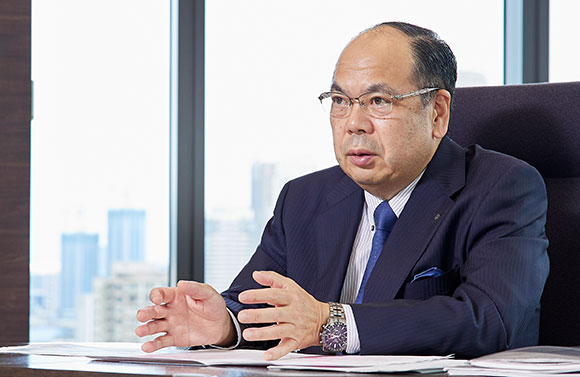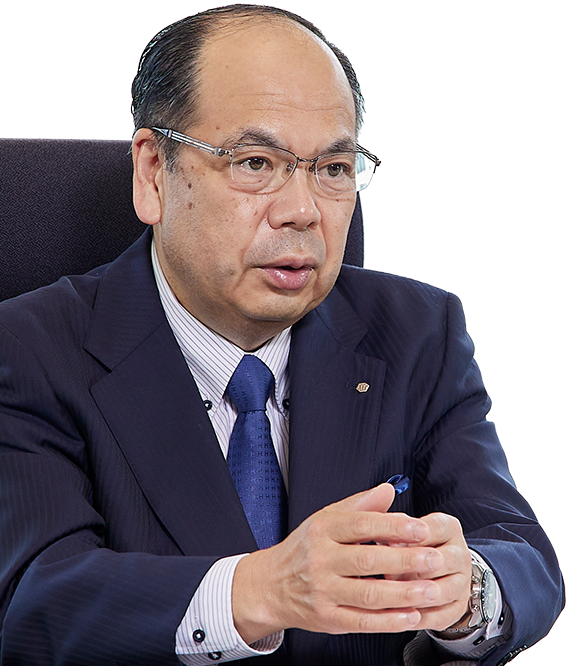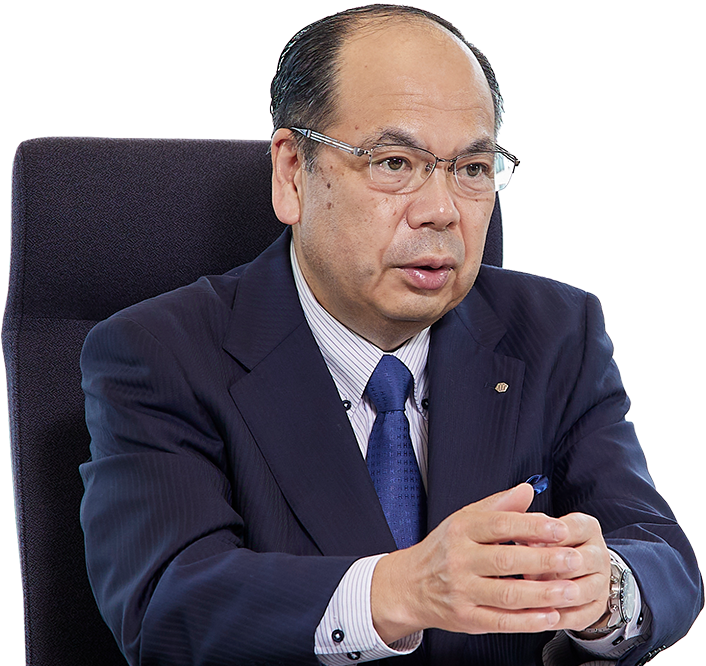Interview with the Director responsible (2025)
The Company has positioned “innovation” as a key issue, but in what areas are you aiming to expand innovation in the future?
The Group has identified priority tasks, such as “achieving zero carbon and a recycling society,” “ensuring healthy lives and improving social services,” and “providing sustainable infrastructure, town and community development, residential environments, and communication environments,” based on the view that by leveraging our current business domains and strengths (strategic foresight, processing, and value transformation), we can contribute to providing solutions with respect to the anticipated megatrends of the future, such as climate change, aging populations, and the diffusion of next-generation communications.
To serve as a compass for business strategy, or, in other words, a guide for which fields we should conduct business in to tackle these social issues, we have produced a strategic area map. On this map, we define domains in which we will expand by extending existing businesses as Enhancement Areas, and domains in which we will create new innovations in light of future trends as Innovation Areas. Each year, following discussions at meetings of the Policy Committee and Board of Directors, we decide where to direct capital in these two types of domains.
How do you choose between in-house development and M&A/CVC when driving innovation?
The sources of value creation in the Group are our technology platforms (TPFs). They define core technologies where we are particularly competitive or that we believe should be further strengthened going forward. With in-house development, we focus on refining these core technologies, and what we emphasize is the concept of technology concentration and market diversification.
Take polyvinyl alcohol (PVA), for example, which the Company has been manufacturing since it was founded. We’ve been perfecting the technology for 78 years. Polyvinyl butyral (PVB) was developed based on PVA, and is used as a binder resin for MLCCs in the electronics field. And, in the form of a film, it is used as an interlayer film in the mobility field. As a new product for the future, we have launched iPS cell culture plates, which open up new possibilities in the field of regenerative medicine in the life science domain. It’s a great example of how technology concentration and market diversification have improved development efficiency and diversified revenue streams.
The Corporate R&D Center manages progress and provides assistance with development themes that span divisional companies. In concrete terms, it plays three key roles: devising development themes that will become next-generation businesses, integrating technologies and providing technical support, and managing Group-wide development.
In contrast, when we can’t resolve an issue with our own core technologies alone, I think it can be effective to bring in external technologies through M&A and CVC. Specifically, we want technologies that can contribute to the creation of next-generation businesses or are aligned with the Innovation Areas of our divisional companies. So, when looking at potential deals, we focus on whether the transaction can produce synergies that can strengthen the Group’s businesses and technologies.
What’s the difference between the roles of the New Business Development Department and the R&D Center?
The R&D Center is responsible for turning “0” into “1,” which means the initial discovery and planning of new R&D themes and the establishment of basic technologies, while the New Business Development Department is responsible for turning “1” into “10,” which means business development, so the latter handles the phase of transforming the technologies and ideas that the former has come up with into businesses. Finally, the divisional companies expand and grow the businesses, turning “10” into “100.”
The criteria for transferring new products and technologies from the R&D Center to the New Business Development Department are determined using a system called Gate Review (GR). GR comprises five stages, 0, 1, 2-1, 2-2, and 3, with business viability and technical progress verified at each stage. Transfers to the New Business Development Department take place after clearing the GR2-1 stage, which means that the basic technology is complete and there are clear prospects for commercialization.
What kind of organization or systems do you think are ideal for new business creation, commercialization, and monetization?
Commercialization and monetization are tasks for the New Business Development Department, so we need the personnel involved to have a certain degree of business sense. In addition, an overarching premise for new businesses is that they contribute to solving social issues, and what I think is important is for us to be an organization with good knowledge and a good feel for the issues so that we can ask ourselves, “Is this really a business that we should be pursuing?” Of course, we also need a certain number of personnel who have already turned “0” into “1.”
C.O.B.U. Accelerator, the in-house entrepreneurship system we launched in FY2023, is also now in its third year. For two straight years, it has attracted more than 100 submissions of ideas for new businesses. I feel it’s been a success in terms of getting so many employees to translate their desire to take on challenges into tangible form, and I hope it will help nurture talent with a thirst for challenge. Meanwhile, what we, as members of the management team, should do is to respond to this keenness to embrace challenge by offering our full support. I believe it’s important to foster a culture in which employees want to continue to take on challenges, while at the same time sharing the harsh realities they will face during the process of commercialization.
The perovskite solar cell business is garnering a lot of attention, but what’s the current state of progress?
Collaboration between industry, academia, and government is advancing, and with support from the national government, we’re in the process of building a new 100 MW production line, and we’re aiming to expand with a 1 GW-level line by 2030. Film-type perovskite solar cells are manufactured using the sealing and coating technologies of the High Performance Plastics Company, and we’re also leveraging the network of ministries, agencies, local governments, and general contractors developed by the Urban Infrastructure & Environmental Products Company to demonstrate that the technology works and to explore markets, and using its technology to establish its construction methods. In addition, the Housing Company is exploring possibilities for installing the cells in detached houses in the future. So one thing that really sets this project apart is the way development is progressing based on synergies between these three divisional companies. We are accelerating development toward mass production and commercialization through installation at Expo 2025 in Osaka, Kansai, and verification tests in Tokyo, Fukushima Prefecture, Fukuoka Prefecture, and other areas.
What kind of discussions does the Board of Directors have when making investment decisions? Are there any differences in the decision-making criteria for existing businesses and new businesses?
There is no significant difference in the decision-making criteria for existing businesses and new businesses. Firstly, the premise is that all new products that will be brought to market in the future will be Products to enhance sustainability, and among projects that are big enough to be discussed by the Board of Directors, there are hardly any that don’t involve Premium Framework products. Our basic approach to potential capital investments is to comprehensively evaluate them using indicators such as ROI and payback period. The recent 100 MW perovskite investment met the criteria, so the Board passed the resolution to approve it.
As for existing businesses, we have 33 businesses classified into four quadrants, and over 60% of investment money goes to growth-driving and growth-potential businesses. If ROIC dips below WACC, an alert is issued, and in the past, the High Performance Plastics Company and the Urban Infrastructure & Environmental Products Company have restructured or withdrawn from businesses in line with this policy.
As you aim for commercialization, how do you manage progress, and are there any criteria you use to determine whether you should proceed with or abandon a project?
Frontline engineers tend to be committed to seeing the technologies they’ve developed through to the end, but new business development involves high technical hurdles and substantial costs, and often does not produce results for many years. Keeping in mind that they’re taking on the challenge of difficult tasks and are under a lot of pressure, management must provide full support and make decisions responsibly, including decisions on whether to continue or abandon an undertaking. To track progress, we use a framework called the “K-value” system to conduct quantitative evaluations based on a market axis and technical axis, and we determine future business viability and growth potential from various perspectives. When making management decisions, we have to carefully ascertain, for example, whether we can’t expect to increase market share any further as the market shrinks, or whether we still have room to expand despite the market itself being mature because our share is still low. Personally, however, and partly because my own background is in engineering, I really want to avoid, as much as possible, decisions to give up because the technology is difficult.
To give one recent example, in the stationary energy storage battery (lithium-ion battery) business we had been continuously losing billions of yen until a few years ago, so we set an initial goal of breaking even by improving battery performance and slashing costs. As a result, we got the business into the black in the fourth quarter of 2024, and we’re about to move into an expansion phase. Even in the case of a new business, it’s difficult to continue technological development when you’re in the red, and I view breaking even as soon as possible as a prerequisite for maintaining the business as a going concern.
Which areas are you targeting for M&A and CVC, and what are your goals?
In our medium-term plan, we’ve earmarked 300 billion yen for investment to realize Vision 2030. M&A and CVC will mainly target the Innovation Areas in the strategic area map, and the High Performance Plastics Company and Medical Business have been playing the central roles in weighing up potential transactions. In the medical CDMO business, prices have soared, so we have to be somewhat cautious, but I think there’s room to continue exploring opportunities in areas in which we have underlying strength.
I also feel that the Urban Infrastructure & Environmental Products Company and Housing Company are starting to make headway. Regarding the Housing Company, for instance, there’s a shortage of carpenters in the construction sector, and this problem is only going to get more serious, so I think we’ll start to enjoy an increasing comparative advantage with the Group’s unit housing, as the houses can be constructed with about half the labor of competitors, so I want to give the Housing Company all the resources it needs to expand its market share. For example, I want to make sure it has sufficient construction capacity. As for the Urban Infrastructure & Environmental Products Company, its operating profit margin is on the cusp of hitting 10%, and it’s entering the next phase, when it will be necessary to expand in volume terms and I think it’ll be able to make inroads overseas, especially with prioritized products. In the Urban Infrastructure & Environmental Products Company and Housing Company, we will continue to anticipate required amounts of investment and seek a balance between risk and return, and execute investments that will lead to growth.
When doing M&A deals, what are you most conscious of? And what are the keys to successful post-merger integration (PMI)?
We avoid paying a high price, and don’t invest solely for the purpose of growing or expanding the areas in which we operate. Instead, we only do deals where we expect to see business or technological synergies. The biggest deal we’ve done so far was the acquisition in 2019 of SEKISUI AEROSPACE, which we bought for around 55 billion yen. But if there were a deal that we absolutely could not pass up, we’d be happy to invest more than 100 billion yen. But our basic stance is that M&A deals should suit us in terms of size, and we don’t consider acquiring large companies.
As for PMI, we’ve been steadily accumulating know-how through our experiences with M&A. The Board of Directors conducts an assessment one year and three years after an acquisition, discussing outcomes and synergies, and improves precision. In addition, we try to minimize the risk of impairment losses, and even if things don’t go as expected, we discuss ways of minimizing the impact. So we have a framework in place for moving cautiously and strategically.
Have there been any innovations or success stories that you personally threw your heart and soul into?

Of the success stories I experienced when I was working in the High Performance Plastics Company, the one that left the biggest impression on me was the complete switch we made to solvent-free production of adhesive tape, which we had previously manufactured using organic solvents. That was 30 years ago, but it was a production process innovation that dramatically reduced production costs while also improving the quality of the tape.
We faced constant difficulties on the road to success, but that success all began when my boss gave us the green light to spend 10 million yen, a huge amount in those days, on lab equipment for our initial experiments. Later, we needed more than two billion yen in additional money for capital investment, and there was no way we would have succeeded without the supportive presence of my boss. Another source of support was my colleagues. I’d often get anxious, saying, “Can we really do this?” But they gave me encouragement every time, responding, “Sure we can!” or “Yes, because we won’t quit till we succeed.” This “won’t quit till we succeed” mentality has served as a motto in my corporate career ever since.
What is your role as Director responsible for new business development, and speaking as Senior Managing Executive Officer, what are your thoughts on innovation?
I believe that my role is to work seriously on “Innovation for the Earth,” the vision statement of Vision 2030, and to demonstrate that attitude to others. When we talk about “solving social issues,” what we’re aiming for is to create a safer, more convenient, and more environmentally friendly society through our business activities, and that necessitates innovation on a global scale. Perovskite solar cells may still be a Japan-centric initiative at the moment, but they have the potential to proliferate worldwide in the future, and they constitute a valuable tool for this innovation on a global scale. So, I’ll be working with all my colleagues across the Group as we take on the challenge of generating “Innovation for the Earth” and strive to realize our vision of creating “peace of mind for generations to come.”


